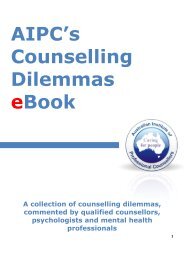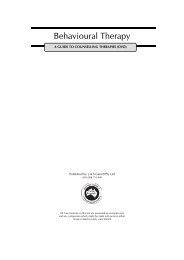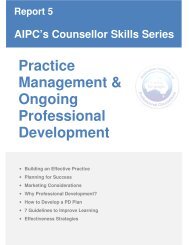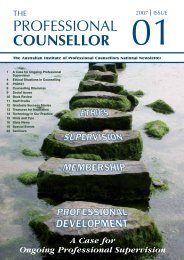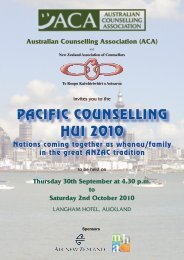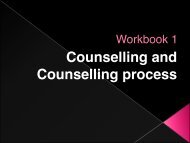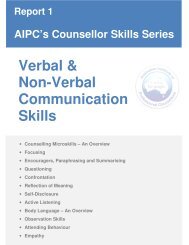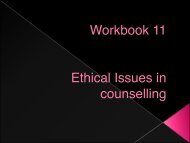Why Diversity? - Counselling Connection
Why Diversity? - Counselling Connection
Why Diversity? - Counselling Connection
- No tags were found...
Create successful ePaper yourself
Turn your PDF publications into a flip-book with our unique Google optimized e-Paper software.
AIPC’s Counsellor Skills Series, Report 3Physical abuse is persistent and/or severe mistreatment by beatings or shaking. Possiblephysical indicators are: broken bones, unexplained bruises, burns, or welts in various stagesof healing. However, often the child or young person gives vague or bizarre explanations ofhow the injuries occurred.There is a history of family violence, there is an unexplained or vague explanation of why adelay occurred between the injury occurring and when medical treatment was sought.Sometimes the parent/s will admit administering the injuries, and other times they may showlittle concern for the welfare or treatment of their child.Sometimes the child will tell a teacher or counsellor of the mistreatment, other times theymay not want to go home, or show fear when in the company of a parent. Children mayattend school dressed inappropriately (such as in long sleeve shirts and jeans when theweather is particularly hot).Psychological abuse is the repetitive ill treatment of a child or young person throughthreats, belittling or teasing comments, humiliating the child, bullying, prolonged ignoring andinappropriate encouragement. Children who have suffered psychological abuse will oftenfeel worthless, unloved, unwanted; they could also have problems with cognition, memory,perception and irrational beliefs based on insecurities.Possible indicators of psychological abuse include, elevated levels of anxiety anddepression, compulsive lying and/or stealing, an inability to trust, indiscriminately seeking theattention or affection of others, rocking, sucking and self harming behaviours. Sexual abuseoccurs when a child has been exposed or subjected to any sexual behaviour that isexploitive and/or inappropriate to his/her age and developmental level.Children who have been subjected to sexual abuse can suffer from severe emotionaltrauma, physical injury, and sometimes infections. Possible indicators of sexual abuseinclude sexualised behaviours that are inappropriate for their age, knowledge of sexualbehaviour inappropriate for their age, disclosure of abuse either directly or indirectly throughdrawings or playing, injury in and around the genital area, the presence of sexuallytransmitted infections.More subtle indications could be the sudden uptake of unexplained fears, enuresis (bedwetting), encopresis (bed soiling), fear of being alone with one person, and the child mayimply that they need to keep “secrets”.Neglect is the deprivation of a child’s basic needs, such as adequate food, shelter, clothingand support. Neglect can be acute, chronic or episodic, and impact on the child’s social,educational and psychological development. Possible indicators of neglect are signs ofmalnutrition (such as hunger) and poor hygiene (such as mattered or dirty hair and/or severebody odour).Sometimes the neglected child will have unattended physical or medical problems (includingfrequent illnesses and infections or sores). It must be stressed that the ongoing priority in allcase work is the assurance and maintenance of child safety. The counsellor needs to be incontact with all the service providers, professionals, carers and or appropriate legalorganisation to ensure that the child is continuously protected.Not only is the cessation of the abuse essential for wellbeing and healing, but if the child isnot protected from being re-victimised, the trusting relationship between the counsellor andthe child can be irreparably damaged. If the abuse continues, the child may lose hope, faithand trust in the ability of the counsellor and other relevant professionals to provide protection(Wickham & West, 2002).Page 24



